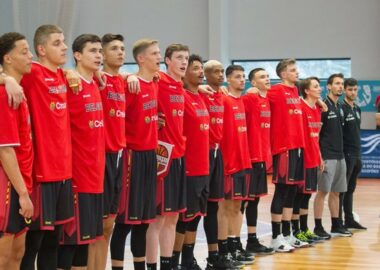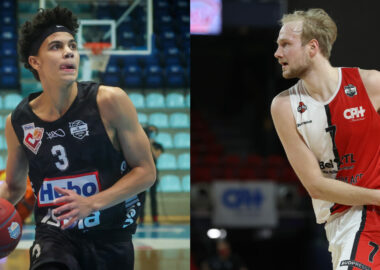
The 10 Greatest European Players in NBA History
(Part 2 of 2) In this second batch of the greatest European players in NBA history, our tribute to European basketball’s enduring legacy continues. In the interest of assessing accomplishments in a more definitive and career-wide context, the list only includes retired or inactive players.
We have a separate list in a series of articles that include active European players in the NBA.
Evolution
Europe has been a source of extraordinary basketball talent since the 1980s. This rise in talented European players changed the way NBA basketball is played. Specifically, today’s players and coaches place much more emphasis on fundamentals, discipline, and all-around expertise regardless of size, height, or position.
From a one-dimensional post-up scorer and rebounder, the “big man’s” role has evolved into a more finessed, multifaceted performer. All five players are legitimate three-point shooter options and the deceptively simple ‘Euro step’ has emerged as a potent offensive move.
Reshaping, Energizing, Inspiring
Over the years, a number of European players have achieved legendary status for their achievements and contribution to the sport. These athletes have reshaped and energized the league and inspired generations of future basketball superstars.
Without further ado, we present our top picks for the 5 to 1 spots.
5. Sarunas Marciulionis, Lithuania
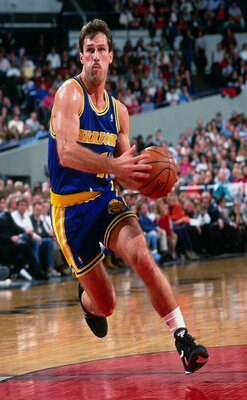
Unlike his countryman and fellow USSR national team player Arvydas Sabonis, Sarunas Marciulionis had a less complicated path to the NBA. In 1989, the Golden State Warriors signed the 25-year-old Marciulionis to a three-year, $3.9 million contract. The Soviet Sports Committee was supposed to get half of his salary but reports say it took as much as 75%.
The shooting guard had led the Soviet national team to the gold medal at the 1988 Seoul Olympic Games. He had also won medals for the Soviet Union in numerous European amateur tournaments. Above all, Marciulionis was the first player from the Soviet Union to compete in the NBA.
Shattering the Stereotype
At that time in the NBA, European players were regarded as one-dimensional spot-up shooters and role-players. Marciulionis shattered the stereotype by playing a physical, bruising game on both ends of the court. At 6 feet 5 (1.96 m) and 200 pounds (91 kg), he was bull-strong yet agile. His height, heft, aggressiveness, physical strength, and scoring proficiency overwhelmed defenders and redefined the traditional guard position. In effect, Marciulionis is credited with introducing the Euro step to the NBA.
Marciulionis played seven seasons for four teams in a career plagued with injuries. He scored 4,361 total points for an average of 12.8 points per game with a 50.5% field goal shooting performance. The Naismith Memorial Basketball Hall of Fame welcomed him in 2014 and FIBA inducted him into the Hall of Fame in 2015.
4. Peja Stojakovic, Serbia/Greece
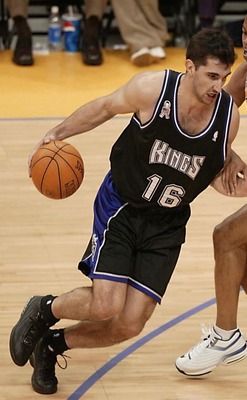
On February 5, 1999, Serbian-born Greek Peja Stojakovic made his NBA debut for the Sacramento Kings. He played just over 17 minutes and scored 2 points in a 101-83 blowout loss to the San Antonio Spurs. Stojakovic spent his first two seasons in Sacramento coming off the bench as a back-up for Corliss Williamson.
After Williamson’s departure, the Kings moved Stojakovic to the starting lineup where he came into his own. The 6-foot-10 (2.08 m) small forward averaged 20.4 points and 5.8 rebounds with 40% shooting from beyond the arc. He finished second in the 2001 Most Improved Player voting behind Tracy McGrady.
Shooting Prowess
Stojakovic amazed Sacramento fans with his three-point shooting prowess from seemingly any angle against any defender. He was also an excellent wingman, a strong finisher, and a tough defender as well as a stubborn rebounder. As he grew more accustomed to the NBA style of play, Stojakovic’s game continued to broaden and mature.
During the 2001-2002 season, his numbers went up to 21.2 points with 48.4% field goal and 41.6% three-point shooting averages. In the 2003-2004 season, he finished with 24.2 points while shooting 48% from the field, 43.3% from three, and 92.7% from the line. Despite being hounded by injuries and lower back problems, Stojakovic remained productive in his eighth and last season in Sacramento.
Playing On
With shooting skills intact, Stojakovic played one season in Indiana, five seasons in New Orleans, and 2 games in Toronto. A knee injury and persistent back pain caused him to miss several games. He won the 2011 NBA Championship with the Dallas Mavericks, playing in 25 regular-season games and 19 playoff matches. Later that year, Stojakovic announced his retirement.
Stojakovic is a three-time consecutive All-Star (2002, 2003, 2004) and a back-to-back NBA Three-Point Contest champion (2002, 2003). He has the fifth-highest free-throw shooting percentage with 89.5% and ranks 21st with the most three-pointers with 1,760. In 2014, the Sacramento Kings retired his jersey number 16.
3. Pau Gasol, Spain
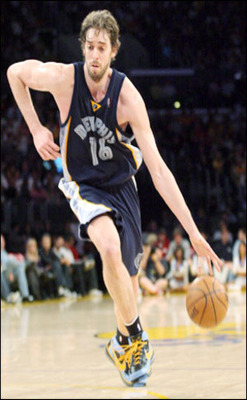
Pau Gasol started his NBA career for the struggling Memphis Grizzlies in 2001. At 7 feet 1 (2.16 m), the athletic Spaniard can play both center and power forward positions with equal efficiency. He finished his rookie season with 17.6 points and 8.9 rebounds per game with a 51.8% field goal shooting average. Gasol was named 2001 Rookie of the Year, becoming the first non-American to receive the honor.
During his first two seasons as a starting center, Gasol never missed a game. By his third year, he had 3,000 points and 1,500 rebounds. Playing for an unremarkable Grizzlies team for seven seasons, he averaged 18.8 points, 8.6 rebounds, and 3.1 assists per game. Despite Gasol’s stellar play, the Grizzlies were eliminated in the first round in consecutive playoff appearances from 2004 to 2006.
Career Highlight
His mid-season move to the Los Angeles Lakers in 2008 was to become the highlight of his career. Motivated and more assertive, Gasol became the Lakers’ ideal big man and the second scoring option, after Kobe Bryant. He exhibited his broad offensive scope, scoring with a variety of mid-range jumpers, hook shots, up-and-unders and post-ups. With the Lakers, Gasol won back-to-back NBA Championship rings in 2009 and 2010. He averaged 17.7 points, 9.9 rebounds, and 3.5 assists on a 52.2% field goal clip in seven seasons in L.A.
Gasol played 6 more seasons for the Chicago Bulls, San Antonio Spurs, and Milwaukee Bucks. However, injuries forced him to retire in 2019. Nevertheless, he achieved more season-highs and personal milestones before then. In a career that spanned twenty years, he averaged 17 points, 9.2 rebounds and 3.2 assists with 550 double-double games. He is a six-time All-Star (2006, 2009, 2010, 2011, 2015, 2016) and a two-time All-NBA Second Team (2011, 2015).
2. Tony Parker, France
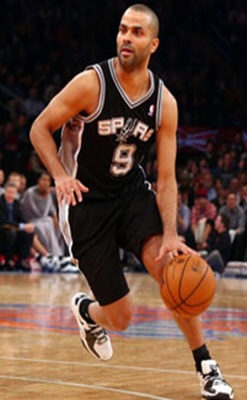
In 2001, Belgian-born Tony Parker was a man in a hurry. He was drafted by the San Antonio Spurs at age 19, just two years after turning pro with French club Paris Basket Racing.
Parker wasted no time proving his value to the Spurs lineup, earning a starting spot early in his rookie season. In fact, he finished his first year with 9.2 points, 4.3 assists and 2.6 rebounds in 29.4 minutes a night. His game was rarely flashy nor spectacular, but he was ultra-efficient and delivered when it mattered most, especially in the postseason. Consequently, the Spurs reached the playoffs in all 17 seasons Parker spent with the team.
The 6-foot-2 (1.88 m), 185-pound (84 kg) point guard had tremendous court vision and basketball IQ. He attacked the paint to draw the defense and find an open teammate, or score with his trademark teardrop floater. Hence, the Spurs won the 2003 NBA Finals against the New Jersey Nets, giving Parker a ring in only his second season. He posted 14.7 points, 3.5 assists, and 2.8 rebounds in 33.9 minutes per game in the playoffs.
The Big Three
The Spurs won three more NBA titles in 2005, 2007 and 2014 against the Pistons, Cavaliers and the Heat, respectively. As part of the “Big Three” with Tim Duncan and Manu Ginobili, Parker’s contributions were crucial to all three championships. In the 2007 Finals’ 4-0 sweep of the Cavaliers, he scored 24.5 for the series, shooting 57.1% from three-point territory. For his performance, Parker became the first European to receive an NBA Finals MVP award.
Parker retired in 2019 with his greatness intact and his legacy unquestioned. He was a six-time All-Star (2006, 2007, 2009, 2012, 2013, 2014) and a three-time All-NBA Second Team (2012, 2013, 2014). The San Antonio Spurs retired his number in 2019.
1. Dirk Nowitzki, Germany
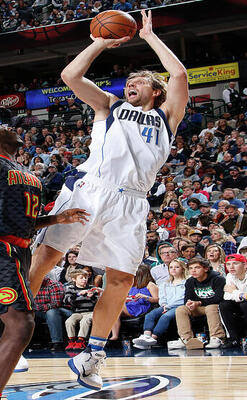
Power forward Dirk Nowitzki played his first game in the NBA for the Dallas Mavericks in the 1998-1999 season. After playing for a second-tier pro league in Germany, Nowitzki was seen as a coachable player with unlimited potential.
Initially, the 7-foot-0 (2.13 m) Nowitzki struggled to adapt to the Mavericks’ rotation and the NBA’s level of play. He ended his rookie year with 8.2 points and 3.4 rebounds in 20.4 minutes per game. In his second season, Nowitzki hit his stride, doubling his production to 17.5 points and 6.5 rebounds. He continued to improve as his fame increased, posting 21.8 points and 9.2 rebounds in his third season. During his fourth season, Nowitzki was named to his first All-Star Game appearance.
Elite Power Forward
The succeeding years saw Nowitzki emerge as one of the elite power forwards in the league. Taller than most forwards, he was a nightmare for opposing defenders. With a keen shooting touch from anywhere on the court, he was essentially a shooting guard in a 7-foot frame. Nowitzki’s unique post-up game opened the floor for various scoring options whenever double or triple teams came his way. As a result, Nowitzki revolutionized the power forward position, shifting its game further from the paint.
Throughout his career, the one-legged, turnaround fadeaway jumper was his go-to weapon among his arsenal of offensive moves. Along with Abdul-Jabbar’s sky hook, Nowitzki’s fadeaway shot is one of the most unstoppable signature shots in basketball history.
Nowitzki spent all his 21 seasons in the NBA with the Dallas Mavericks. He led the team to its first and only NBA Finals Championship in 2011 where he won the Finals MVP trophy. In 2007, Nowitzki became the first European to be named NBA Most Valuable Player. He is a fourteen-time All-Star and a four-time All-NBA First Team member. Moreover, he is the first European, and the sixth NBA player to reach the 30,000-point milestone. Nowitzki is certain to be enshrined into the Naismith Memorial Basketball Hall of Fame once he becomes eligible in 2022.
(The 10 Greatest European Players in NBA History)
Conclusion
It’s always tricky to compile a top 10 best list of anything. Sports lists in particular, often spark debates and disagreements. Some protest the order of the list while others object to the absence of specific players. For sure, there are many factors that can’t be measured by statistics, titles, awards, or efficiency ratings.
But sports lists are fun precisely because they arouse good-natured, lively discussions, preferably over a cold beer at a favorite pub. So, cheers!


